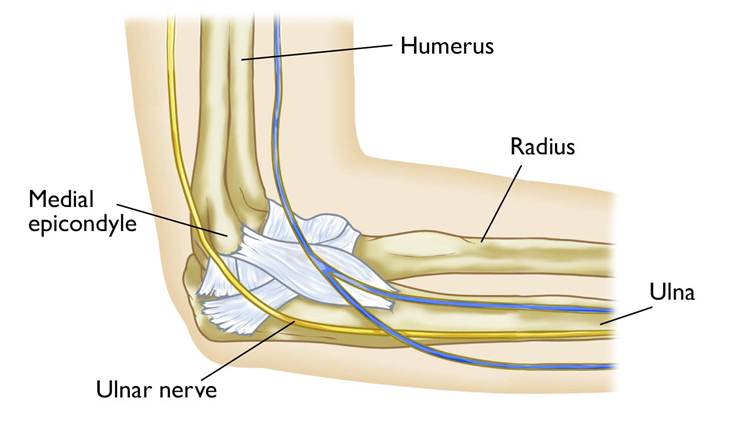Nerve compression in the elbow, often referred to as cubital tunnel syndrome, is a condition where the ulnar nerve (commonly known as the “funny bone” nerve) becomes compressed or irritated. This can lead to pain, numbness, or weakness in the hand and fingers, especially the ring and little fingers.
Understanding the Ulnar Nerve
The ulnar nerve runs from your neck down to your hand. At the elbow, it passes through a narrow tunnel of bone and tissue called the cubital tunnel. When this nerve gets compressed at the elbow, it affects its ability to send signals, resulting in discomfort and dysfunction.
Common Causes of Elbow Nerve Compression
1. Frequent Elbow Bending
- Repetitive bending or prolonged flexion of the elbow can stretch and irritate the ulnar nerve.
- Common in people who sleep with their elbows bent or work long hours on the phone.
2. Leaning on Elbows
- Habitually resting your elbows on hard surfaces (e.g., desks) puts direct pressure on the ulnar nerve.
3. Direct Trauma
- A blow to the inside of the elbow (funny bone area) can temporarily compress the nerve, causing tingling or electric shock-like sensation.
4. Arthritis or Bone Spurs
- Joint inflammation or abnormal bone growth can narrow the cubital tunnel and compress the nerve.
5. Cysts or Tumors
- Masses around the elbow joint may apply pressure to the nerve.
6. Previous Elbow Fractures or Dislocations
- Injuries can alter the anatomy of the elbow and increase risk of nerve entrapment.
Symptoms of Ulnar Nerve Compression
- Tingling or numbness in the ring and little fingers
- Hand weakness or clumsiness
- Difficulty gripping or holding objects
- Pain or aching on the inner side of the elbow
- Worsening symptoms when elbow is bent for long periods
Diagnosis
Doctors may use:
- Physical examination (e.g., Tinel’s sign at the elbow)
- Nerve conduction studies (NCS) and electromyography (EMG) to assess nerve function
- X-rays or MRI scans to check for structural causes like arthritis or growths
Treatment and Fixes
Non-Surgical Options
- Activity Modification
- Avoid leaning on elbows or prolonged elbow bending.
- Use a headset for phone calls instead of holding the phone.
- Elbow Splint or Brace
- Wearing a splint at night can prevent elbow flexion and reduce pressure on the nerve.
- Physical Therapy
- Nerve gliding exercises help maintain nerve mobility.
- Stretching and strengthening surrounding muscles may also reduce symptoms.
- Medications
- NSAIDs (like ibuprofen) can help reduce inflammation and pain.
Surgical Options
If conservative treatments fail or symptoms worsen, surgery may be recommended. Surgical options include:
- Ulnar nerve decompression: Relieves pressure by opening the cubital tunnel.
- Ulnar nerve transposition: Moves the nerve to a new position to avoid irritation.
- Medial epicondylectomy: Removes part of the bone that may be compressing the nerve.
Home Care Tips
- Keep your elbows straight when possible.
- Use soft pads if you must lean on your elbows.
- Take frequent breaks from activities that require repetitive elbow movements.
Conclusion
Nerve compression in the elbow can interfere with daily life, but with early recognition and proper treatment, it can often be managed effectively. If you experience persistent numbness, tingling, or hand weakness, consult a healthcare provider to prevent long-term nerve damage.
Disclaimer: This blog is for informational purposes only and should not be considered a substitute for medical advice. Always consult a licensed healthcare professional for a proper diagnosis and treatment.
